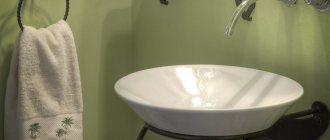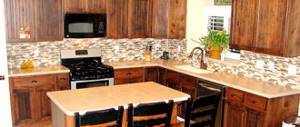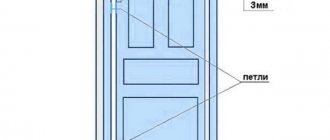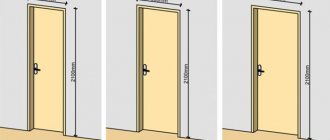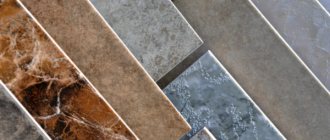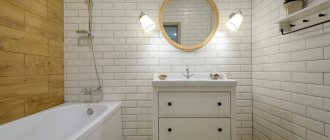<
>
The arrangement of a room intended for performing water procedures includes not only plumbing equipment. One of the important elements is the cabinet under the sink in the bathroom. This product will provide additional comfort and add completeness to the interior.
Vanity cabinet in the bathroom - advantages and features
The presence of this piece of furniture provides a number of advantages.
- A combination of storage space and plumbing fixtures in one product.
- All the necessary things are compact and hidden.
- At the same time, communications are closed, so there is no need for additional actions to mask them. To ensure free access to the pipes, simply empty the shelves and remove them from the cabinet.
- The bedside table under the bathroom sink sets the overall style of the interior. Thanks to a wide selection of models, it is easy to choose a model that fully meets all requirements.
- The space under the thicket is rationally used and there is no need to equip storage areas.
If the size allows, then a cabinet under the bathroom sink can even hide a washing machine, as well as a container for dirty laundry, a hair dryer, an electric razor, a massager, etc.
Coverage options
Dyeing is usually done in factories or factories, without the participation of workers. Typically, such products are of the highest quality and have virtually no defects. If such a problem occurs, then these are unpainted parts - which can be easily seen by the differences in color, or overpainted parts - which can be determined by carefully examining the ends of the products.
Lamination guarantees the high quality of all parts of the product. At the factory, the body is laminated automatically, the rest is done by workers in factories. Monitor the integrity of the film - there are cases of its swelling, damage during transportation, and qualitative changes due to temperature changes.
The highlight of the bedside table can be the fittings. It usually receives little attention, but should not be discounted. Handles and fasteners play a significant role in vanity units. You can choose handles made of plastic, metal or wood.
It is important for a bedside table to have stable legs; if you have differences in the bathroom, you can choose a model with adjustable height legs. Modernized cabinets have plastic bases - if you have heated floors, it would be wise to abandon this option.
Pay attention to the fastenings, they are:
- conventional fasteners, domestically produced;
- with a long service life, they are produced in Europe;
- elite, such fastenings are carried out by world-famous organizations.
How the cabinet under the bathroom sink is arranged - features
A vanity unit for a bathtub is a special type of furniture that performs different functions. It consists of several structural elements:
- table top;
- frame;
- sidewalls;
- shelves;
- facade.
<
>
There is no back panel, allowing easier access to the pipes. To impart rigidity to the entire structure, metal corners are provided in the lower part, and a special strip in the upper part.
Special requirements are imposed on materials used in production. This is due to high humidity and frequent changes in temperature.
- Resistant to steam and water.
- Mechanical strength.
- Immunity to mold and corrosion.
- No deformation changes during operation.
For production they use: laminated chipboard, MDF, plastic, glass, wood, metal.
Products made from chipboard have the lowest performance. Even the presence of hydrophobic impregnations does not provide 100% protection against moisture.
Wood treated with a moisture-resistant compound is more reliable, but costs much more. Such furniture is suitable for large rooms with a good ventilation system. Otherwise, deformation and destruction of the material cannot be ruled out.
<
>
A product made of MDF, which resembles wood in appearance, will cost less. It has a protective moisture-resistant coating, is not afraid of temperature changes and is resistant to mechanical stress. These characteristics guarantee a long service life.
A stainless steel coating will protect metal surfaces, but it is worth considering the overall design style of the room so that such a cabinet with a bathroom sink does not look like a foreign object.
High quality plastic is durable and long lasting. There is a wide variety of colors and textures, and it does not require complex care or special products.
Tempered glass, complemented with chrome-plated or nickel-plated fittings, withstands the special conditions of the bathroom. Such products can be matted or painted in different colors, which will help to create bright accents. The disadvantages include the high price and the need for constant maintenance, since drops of water leave unsightly marks on the surface.
<
>
Nightstands come in different shapes. Its choice depends on a number of factors:
- room size;
- location;
- individual features of the room.
The simplest option is in the form of a rectangle or square.
For a small room, a triangular structure installed in the corner is suitable. This approach saves space and provides good capacity.
Models with six or eight edges that evenly frame the bowl look interesting.
If the product is made to order, its geometry may have rounded and asymmetrical shapes. This reduces the risk of injury and adds softness to the interior.
In most cases, the bathroom is not very large. This factor should be taken into account when choosing a vanity unit. The most common models are 50-55 cm wide and 80-90 cm high. If the size of the room allows, then increasing the width is allowed. To ensure convenient use for younger family members, you will have to take care of a special stand in the form of a ladder. Taking measurements at the installation site will help you finally determine the dimensions.
Types of shells
Once the choice of cabinet has become obvious, it’s time to move on to choosing a sink. Even though these are two different elements, in the end you will get one solid product in the bathroom interior. Therefore, the sink and cabinet should look harmonious together.
The main criteria for choosing a sink, regardless of the parameters of its support:
Magnitude. A large sink on a bulky cabinet will look rude in the interior of a small bath, just as a small sink will “get lost” in a spacious room.
Unity of style. The washbasin should match the overall design of the bathroom.
Ergonomics. Characterizes ease of use - location, height, availability of space for personal hygiene items, etc.
Safety. Due to their fragility, glass sinks are not safe for small children. You should be careful when choosing wall-mounted washbasins; built-in and supported ones are much safer.
The standard width of an average sink is from 50 to 65 cm. The maximum is 90 cm. At the same time, there are also non-standard models with a width of up to 50 cm and over 90 cm. If there is a need to install an even larger sink, then it makes sense to consider the option of installing two washbasins.
Shapes and colors of bathroom sinks
Technological advances and the variety of materials that can be processed make it possible to produce sinks in a wide variety of shapes. Quite unusual, far from geometric - this is avant-garde. I want to draw your attention to those that can be found in all specialized stores:
- rectangular - a universal type, suitable for almost any interior;
- round - must be combined in design with other round objects;
- square - would be appropriate in a simple style;
- oval - a non-standard shape that best suits a similar design.
Contrary to the prevailing stereotype, the sink should not only be white. Even the brightest colors can successfully fit into the overall style if they are selected correctly. Hand painting on ceramics or glass is becoming increasingly popular, but such pleasure is not cheap.
Types of designs
<
>
Depending on the installation method, suspended, floor-mounted and built-in structures are distinguished.
Floor-standing
The floor installation option is considered the simplest. It has good stability and is reliable in operation. Able to withstand the weight of the shell and become a support for an adult. If the material is chosen correctly, the product will serve for many years.
However, in case of unforeseen situations (water spill, leak), the lower part of the structure may be damaged. To reduce the consequences, it is better to choose furniture with legs. Supports made of metal or plastic can boast of particular reliability. It is important that they are in harmony with the rest of the elements and design of the room. There are models with height-adjustable legs, which is especially convenient for families with small children. The presence of a heated floor system is not an obstacle to the installation of products of this type.
To avoid unwanted sliding and protect the floor surface from scratches, silicone gaskets are placed under the legs. Professionals also advise fixing the structure to the wall to increase safety.
Base models are the most stable. Their assembly will not cause any difficulties even for a novice master.
However, if you use a cabinet that rests on a plinth, there is a chance that mold will develop underneath it, and it will be quite difficult to maintain proper cleanliness. It is recommended to coat the perimeter of the plinth adjacent to the floor with silicone sealant. And also ensure that the ventilation system works well.
Rare materials are able to withstand constant exposure to moisture. In a few years the question will arise about replacing the base. It is a special base stand made of planks that hides the space under the furniture. Creating a structure on legs will save the situation, and the resulting niche can be closed with removable panels that can be easily disassembled if necessary.
Hanging
The hanging method of installing the cabinet requires a reliable place to attach the structure. These requirements are met by load-bearing walls that can withstand significant weight. This cabinet is considered easy to clean, provides good air circulation and visually expands the space.
Fastening is carried out using metal brackets, installation, and special screws.
Built-in
The built-in design saves usable space. Usually installed in a corner. In this case, part of the elements are walls. The model is both compact and roomy, and also allows you to use an area that is not in use. It is shaped like a triangle or trapezoid. There are also asymmetrical options, elongated to the left or right, depending on the geometry of the bathroom.
You can mount such a cabinet on the floor using legs or a plinth, or hang it on brackets.
What types of cabinets are there?
Particularly popular are models with two or three doors. They have large or compact dimensions. There are cabinets based on wheels, where there is no sink. In this case, the washbasin is mounted separately from it on the wall. They can be supported by legs, plinths or hanging mounts.
Base versions make it easier to care for the bedside table. Modifications with legs are also good, however, it is ideal to use a chrome coating on the base of the linings along with them. If the bathroom has a heated floor, a hanging bedside table is suitable for it. A cabinet with a built-in sink is particularly practical.
However, it is worth highlighting separately the models that have additional devices. We are talking about cabinets with baskets for dirty laundry. They can be retractable and this helps create unprecedented ergonomics in the room. This design was invented relatively recently, however, it has already proven itself from the best side.
- Paper towel dispenser - 127 photos of modern devices for dispensing paper towels
Bathroom rack (108 photos): types, materials, design ideas and modern options from IKEA
- Bathroom basket - main types, design of built-in and wall-mounted types of baskets (100 photos)
Methods for installing a sink on a bathroom cabinet
There are several options for installing a sink in a cabinet: overhead, mortise and furniture-mounted.
Overhead sinks
The countertop sink is located on the countertop, which has a hole for a siphon. In this case, special bowl models are used. Particular attention should be paid to the height of the sink. The optimal value is in the range from 80 to 90 cm.
This option does not require careful sealing of the gap between the countertop and the washbasin.
A variation of this type of installation is the semi-recessed method. Part of the sink protrudes beyond the cabinet, this allows you to take a closer position to the bowl. This method is suitable for small bathrooms where it is not possible to use a standard size countertop.
Mortise models
A mortise sink is installed in the prepared hole so that the edges of the bowl are flush with the countertop or rise by 1-2 cm. This increases the usable working surface area and looks very attractive. Installation work does not require special skills or complex tools.
The most convenient are the bowls that are built in from below. The absence of protruding sides makes maintenance much easier.
Furniture-mounted sinks
The solid-cast countertop with sink is characterized by the absence of cracks and joints, which eliminates the possibility of leaks. It completely covers the top of the cabinet. Maintenance is minimal, however, the cost of such products is quite high, and in case of mechanical damage, a complete replacement of the set will be required. Another feature is the heavy weight of the product.
Materials, sizes and shapes of sinks for bathroom cabinets
Different materials are used to make a sink.
- Natural stone (onyx, marble, travertine, granite) looks noble. Such products are highly durable and hygienic, but they are heavy and expensive, and also require delicate care.
- Only shockproof glass is used. It can be transparent or matte, and also painted in various shades.
- Ceramic bowls are most often in demand. They are presented not only in white, but also in other colors. They are easy to care for.
- Artificial stone can serve as an alternative to natural stone. Compared to it, it is lighter in weight, affordable and easy to maintain. The color design can satisfy the most demanding taste.
- Copper and bronze are used if it is necessary to implement a design solution.
The shapes of sinks are: round, oval, rectangular, square and asymmetrical.
Based on the size of the bowl, there are 3 groups:
- large with a length of 75 cm and a depth of 48-61 cm;
- medium ones are characterized by a length of 55-75 cm and a depth of 35 to 48 cm;
- small ones have the following parameters: length 40-45 cm, depth 12-35 cm.
If space allows, then you should think about installing a cabinet with two sinks. This is especially useful in a large family.
A double sink will add style and originality to your bathroom design.
Types of countertops for sink cabinets
To make a countertop for a bathroom sink and cabinet, different materials are used. Their choice depends on financial capabilities, style, room size and personal preferences.
- Natural stone ranks first in strength, durability, resistance to moisture and visual appeal. However, such a product is heavy and expensive.
- Special glass looks stylish and light. The surface is not susceptible to moisture and is resistant to mechanical stress. The downside is the difficulty of adjusting to the size of the sink, as well as the need for constant maintenance.
- Wood will fill the bathroom with a pleasant aroma and make the atmosphere warmer. Not all species are suitable for countertops; pine, oak or teak are most often used. The price of solid wood products is quite high, and the service life does not exceed 8-10 years.
- Finishing the countertop with ceramic tiles gives a holistic perception of the bathroom space. The cost is affordable, the surface requires easy maintenance and will last a long time.
- Artificial stone is not inferior to natural stone in many qualities, but it is more susceptible to mechanical damage. Minor scratches can be removed by polishing with a special paste. In terms of tactile sensations, the surface of the product resembles silk fabric.
- Laminated chipboard and MDF are considered a budget option. Treatment with special compounds and a protective laminate coating extends the service life, but constant exposure to aggressive factors gradually leads to the destruction of the material and requires complete replacement.
Dimensions for corner models
Small sinks with a width of 40 cm are often used for bathrooms, office or country premises. Sometimes such sinks come complete with a small cabinet in which you can store useful things. Optimal sizes for small corner sinks: from 46×46 cm. These values indicate their location along 2 walls.
There is a corner model of sinks, which can be with an open bottom (hung on brackets) or with a pedestal. For small apartments, a small sink is installed above the horizontal washing machine. The washbasin is characterized by a small depth and dimensions of the upper part of the machine.
The open lower part under the sink can be covered with a special material to hide the drainage system. A corner washbasin with an open bottom takes up minimal space, so it is possible to place some kind of shelf below.
You can also use a corner version with a pedestal - the washbasin will be on a leg in which the drainage system will be hidden. The leg takes up a lot of space under the sink, which can be used more efficiently. But this option with a pedestal looks more aesthetically pleasing.
Height
Suspended structures are mounted on the wall using special brackets. The height of the mounts can be determined independently, which will allow you to use the product comfortably. This cannot be done in a pedestal sink. It is impossible to adjust the height of the leg, so the product is fixed at a certain height from the floor. If you install a medium-sized sink on consoles, then under the product you can place a small laundry basket or shelf for towels.
Height of washbasin on a ceramic pedestal
In a spacious room, the option with a pedestal looks good. The base of this product perfectly complements the interior. Then the height of the equipment is important. The standard height can be 80-85 cm. To ensure comfort during procedures for all family members, you should know the values: for comfortable use of a washbasin by a man, the equipment should be installed at a height of 94-110 cm from the floor, for women from 81 to 92 cm. The optimal height for installing a washbasin will be 86-93 cm.
The standard installation height of a washbasin for kindergartens is 55-60 cm from the floor, for teenagers this height is 65-70 cm. For an adult, the height can be from 80 cm. Medium and large-sized sinks are good because they provide the opportunity to hide communications.
Optimal height
Depth
A parameter such as depth indicates the distance from the wall to the front edge of the washbasin. As mentioned above, the optimal depth is considered to be from 48 to 61 cm. If we talk about mini versions, their depth can be 26 cm. Large models also have a low depth. For example, a washbasin 1200 cm wide may have a depth of 31 cm. Such a product may have a large countertop that can accommodate various toiletries. Such sinks are chosen when there is enough free space along the wall, but there is not enough distance for depth.
The correct choice of depth is an important indicator. The lower this characteristic, the greater the likelihood of water splashing. Models with a pedestal are ideal in this regard, because such models have standard dimensions.
Depth
Internal filling - what can a cabinet with a sink store?
The interior space of the cabinet is equipped with shelves, drawers, and a mesh laundry basket. Containers with partitions for storing various small items will come in handy. In some models, it is possible to change the height of the compartments depending on the purpose. A large bathroom cabinet with sink can even accommodate a washing machine.
Color
The tones of a bathroom define its style. Calm colors are usually used in a classic style - white cabinets are suitable here, they are universal and are in greatest demand, or cabinets in pastel colors. In a modern setting, you can choose a variety of colors - red, purple and even black.
A catalog with photographs of sink cabinets will help you decide on a color. It can be viewed in any specialized store and on the Internet.
Facades - opening methods, coating materials and types of decor
The cabinet facade is equipped depending on the availability of free space and the design of the product. It can be:
- swing doors;
- sliding doors;
- drawers.
The first option is considered the most reliable, but requires free space for normal operation. The number of sashes depends on the width of the product. When the size is up to 40 cm, one door is sufficient; when the size increases to 60–80 cm, it is advisable to install two.
The sliding design saves space, but makes it difficult to view the contents by 50%. In addition, it is necessary to ensure the cleanliness of the guides.
Drawers are a practical way to decorate the facade. Experts advise choosing models in which their dimensions correspond to the dimensions of the wall tiles.
By design, facades can be solid or framed.
The first ones are a canvas made of one material.
The second option consists of framing and insertion. This method gives more possibilities for design and combination.
The following are used as protective coatings for chipboard and MDF:
- self-adhesive polymer film has very low performance characteristics;
- Sheet acrylic is more reliable provided that the joints are sealed well;
- The veneer is additionally coated with several layers of varnish to increase its service life;
- eco-veneer is a polymer material that is impervious to high humidity, but its appearance is somewhat inferior to the previous version;
- enamel will give the surface the necessary durability and attractiveness;
- The varnish is suitable for treating almost any surface, but requires regular updating.
The decorative design of the cabinet facade is selected in accordance with the overall style. A number of techniques are used for these purposes:
- backlight;
- thread;
- inlay;
- mosaic;
- stained glass or mirror inserts;
- unusual fittings.
